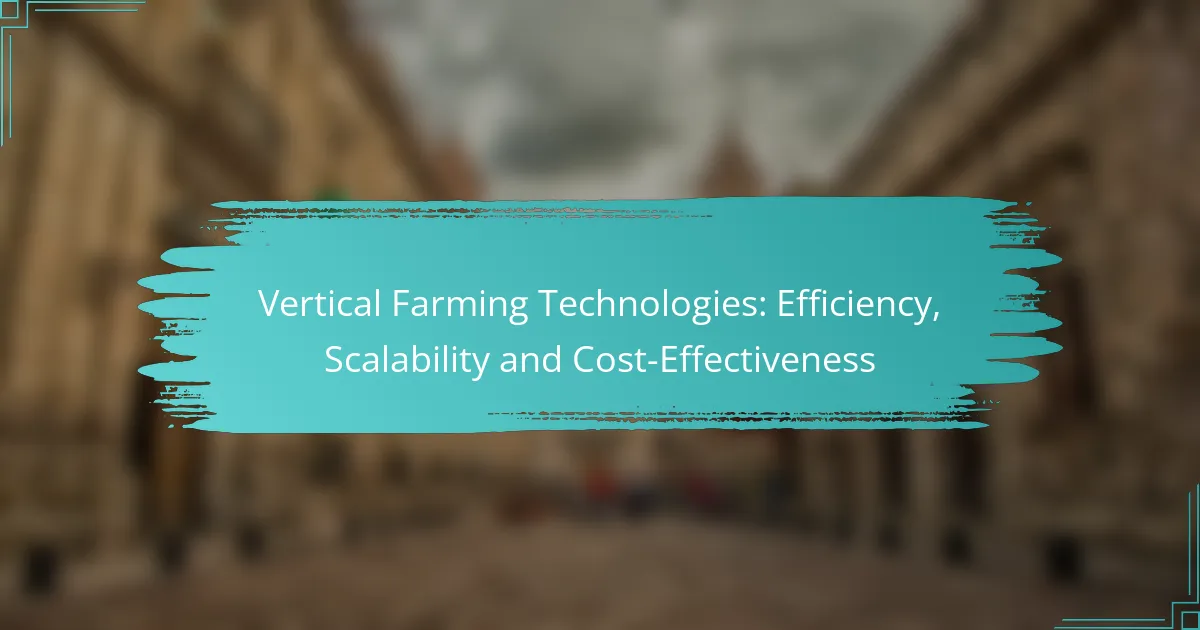Vertical farming technologies are revolutionizing agriculture by enhancing efficiency, optimizing resource use, and maximizing crop yields within confined spaces. By creating ideal growing conditions through advanced systems, these methods not only improve scalability with modular designs and urban integration but also offer a pathway to cost-effectiveness, balancing initial investments with long-term returns and higher yields compared to traditional farming practices.
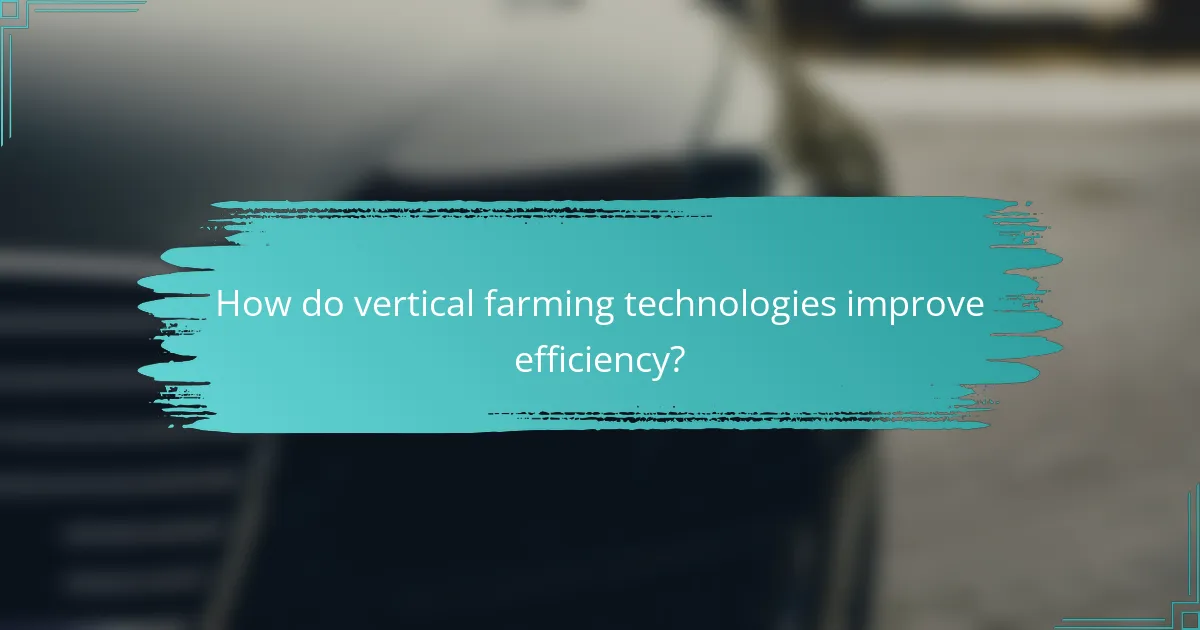
How do vertical farming technologies improve efficiency?
Vertical farming technologies enhance efficiency by optimizing resource use, reducing waste, and maximizing crop yields in limited spaces. These methods leverage advanced systems to create ideal growing conditions, ensuring plants receive the necessary nutrients, light, and climate control for rapid growth.
Hydroponics systems
Hydroponics systems grow plants in nutrient-rich water instead of soil, which allows for faster growth rates and higher yields. This method uses less water than traditional farming, often reducing usage by up to 90%, making it particularly effective in areas with limited water resources.
By eliminating soil, hydroponics also minimizes pests and diseases, leading to healthier crops. However, initial setup costs can be significant, so careful planning is essential to ensure long-term profitability.
Aeroponics systems
Aeroponics systems suspend plants in air and mist their roots with nutrient solutions, promoting rapid growth and efficient resource use. This method can reduce water usage by up to 95% compared to conventional farming, making it highly sustainable.
While aeroponics can yield crops faster, it requires precise control of environmental factors and can be more sensitive to system failures. Regular maintenance and monitoring are crucial to prevent crop loss.
LED lighting advancements
LED lighting advancements have revolutionized vertical farming by providing tailored light spectra that enhance photosynthesis and growth rates. These energy-efficient lights consume less power and can be adjusted to optimize plant growth at different growth stages.
Using LEDs can reduce energy costs by up to 50% compared to traditional lighting. However, selecting the right spectrum for specific crops is vital for maximizing efficiency and ensuring quality yields.
Automated climate control
Automated climate control systems regulate temperature, humidity, and airflow in vertical farms, creating optimal growing conditions year-round. These systems can significantly improve crop consistency and reduce labor costs by minimizing manual adjustments.
Investing in reliable sensors and automation technology is essential for maintaining the desired environment. However, initial costs can be high, so it’s important to evaluate the potential return on investment.
Data analytics for crop management
Data analytics in vertical farming involves collecting and analyzing data on plant growth, resource usage, and environmental conditions to make informed decisions. This technology helps optimize inputs and predict crop performance, leading to better yields and reduced waste.
Implementing data analytics can enhance operational efficiency, but it requires investment in software and training. Farmers should focus on key performance indicators to track progress and make adjustments as needed.
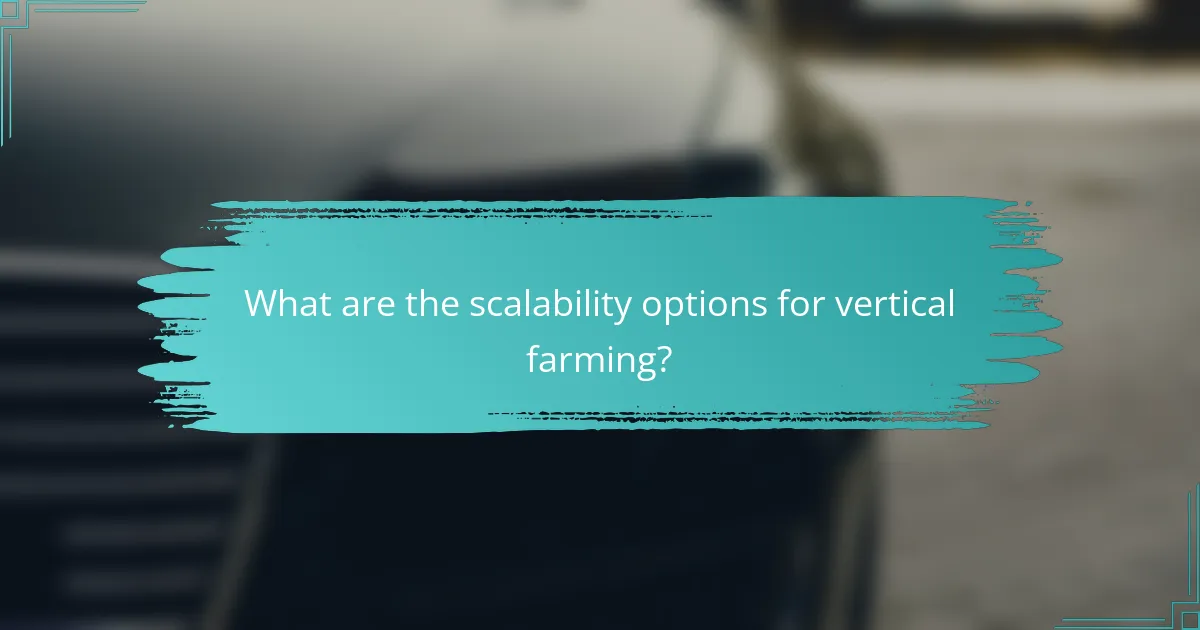
What are the scalability options for vertical farming?
Vertical farming offers several scalability options that enable operations to expand efficiently. These options include modular designs, urban integration, franchising, and partnerships with grocery chains, each providing unique pathways to increase production and market reach.
Modular farm designs
Modular farm designs allow for easy expansion by adding new units as demand grows. These systems can be pre-fabricated and transported to various locations, making them adaptable to different urban settings. This flexibility can significantly reduce setup times and costs, allowing operators to scale operations quickly.
For instance, a modular unit might produce a few hundred kilograms of produce per week, and as market demand increases, additional modules can be integrated to boost output without extensive renovations.
Urban integration strategies
Urban integration strategies focus on incorporating vertical farms into existing city infrastructure, such as rooftops and vacant lots. This approach not only maximizes space but also minimizes transportation costs and carbon footprints. By situating farms closer to consumers, businesses can ensure fresher produce and reduce logistical challenges.
Successful urban integration often involves collaboration with local governments to navigate zoning laws and building codes, ensuring that farms can operate legally and efficiently within city limits.
Vertical farming franchises
Franchising vertical farming operations allows for rapid expansion by leveraging established brand recognition and operational frameworks. Franchisees can benefit from shared resources, training, and marketing support, which can accelerate their entry into the market. This model can be particularly effective in regions with high demand for local produce.
For example, a franchise might require an initial investment ranging from tens of thousands to low hundreds of thousands of dollars, depending on the scale and technology used, but the potential for profitability can be significant with the right location and management.
Partnerships with local grocery chains
Forming partnerships with local grocery chains can enhance the scalability of vertical farms by providing a steady distribution channel for products. These collaborations can lead to exclusive contracts, ensuring that the farm’s produce reaches consumers quickly and efficiently. Such partnerships can also help in building brand loyalty and consumer trust.
When negotiating with grocery chains, it’s essential to consider factors like pricing strategies and supply consistency, as these will directly impact the farm’s profitability and long-term viability in the market.
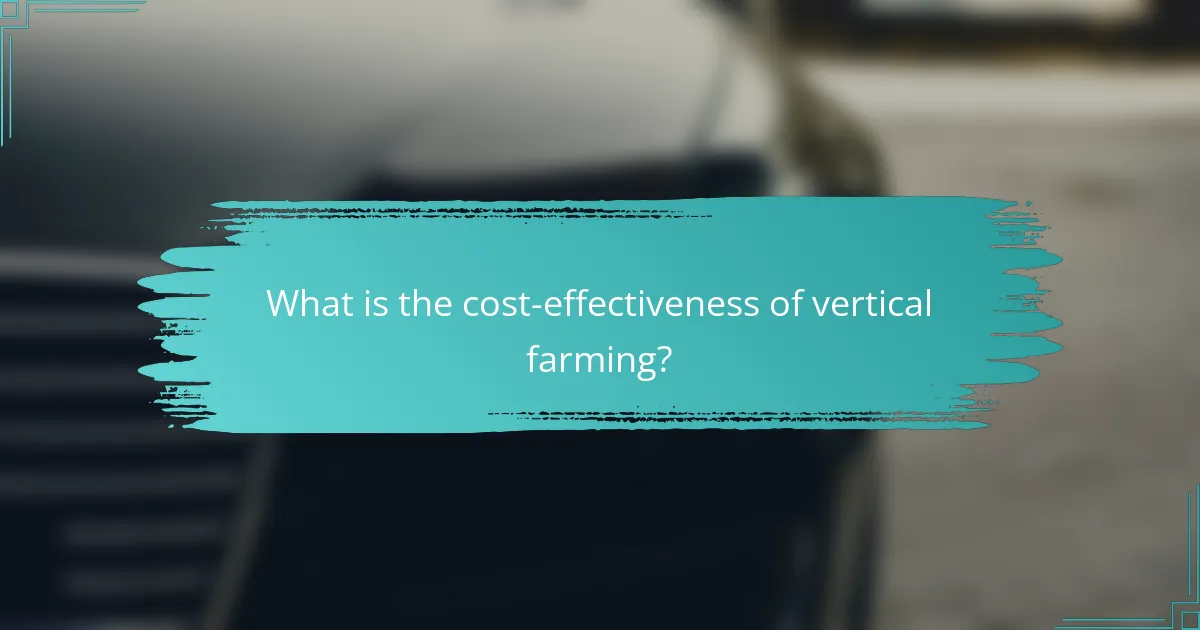
What is the cost-effectiveness of vertical farming?
The cost-effectiveness of vertical farming is determined by its initial investment, ongoing operational costs, and potential returns. While vertical farming can require significant upfront capital, it often leads to lower long-term costs and higher yields compared to traditional agriculture.
Initial investment analysis
Initial investments in vertical farming can vary widely, typically ranging from hundreds of thousands to several million dollars depending on the scale and technology used. Key expenses include land acquisition, construction, equipment, and technology such as LED lighting and climate control systems.
Investors should consider the type of crops being grown, as some high-value crops may justify a higher initial investment. Grants and subsidies may be available in certain regions to offset costs, making it essential to research local funding opportunities.
Operational cost breakdown
Operational costs in vertical farming generally include energy, labor, water, and nutrient supplies. Energy costs can be significant due to the reliance on artificial lighting and climate control, often accounting for a substantial portion of monthly expenses.
Labor costs can be lower than in traditional farming due to automation, but skilled workers may demand higher wages. Regular monitoring and maintenance are crucial to ensure efficiency and minimize unexpected costs.
Return on investment timelines
Return on investment (ROI) timelines for vertical farming can vary, often ranging from 3 to 7 years. Factors influencing ROI include crop selection, market demand, and operational efficiency. High-value crops like herbs and leafy greens tend to yield quicker returns compared to slower-growing varieties.
Monitoring market trends and adjusting crop production accordingly can enhance profitability and shorten ROI timelines. Investors should be prepared for fluctuations in returns based on seasonal demand and competition.
Comparison with traditional farming
When comparing vertical farming to traditional farming, vertical systems often achieve higher yields per square meter due to optimized growing conditions. However, traditional farming typically has lower initial capital requirements and can be more cost-effective for staple crops.
Vertical farming can reduce transportation costs and spoilage by locating farms closer to urban centers, thus providing fresher produce. However, the energy-intensive nature of vertical farms may lead to higher operational costs, which must be weighed against the benefits of increased productivity and reduced land use.
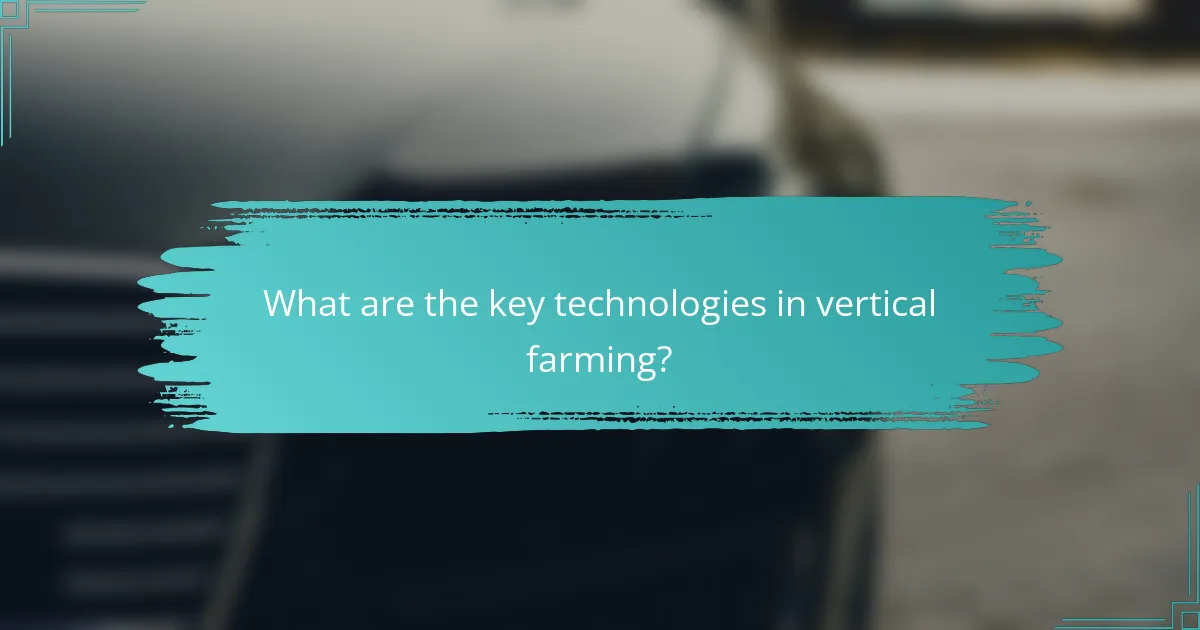
What are the key technologies in vertical farming?
The key technologies in vertical farming include vertical racking systems, smart irrigation technologies, climate control systems, and crop monitoring sensors. These technologies work together to optimize space, resource use, and crop yield in controlled environments.
Vertical racking systems
Vertical racking systems maximize space by allowing crops to be grown in stacked layers. This design can significantly increase the number of plants per square meter, making it ideal for urban settings where land is limited.
When choosing a racking system, consider factors such as material durability, ease of access for maintenance, and compatibility with your chosen crops. Common materials include metal and plastic, each offering different benefits in terms of weight and cost.
Smart irrigation technologies
Smart irrigation technologies automate the watering process, ensuring that plants receive the right amount of water at the right time. These systems can include drip irrigation, misting, and hydroponic setups, which reduce water waste and improve plant health.
Implementing smart irrigation can lead to water savings of up to 50% compared to traditional methods. Monitoring soil moisture levels and adjusting watering schedules based on plant needs can further enhance efficiency.
Climate control systems
Climate control systems regulate temperature, humidity, and light levels to create optimal growing conditions for crops. These systems often include heating, ventilation, and air conditioning (HVAC) units, as well as grow lights that simulate natural sunlight.
Investing in advanced climate control can lead to faster growth rates and higher yields. Consider using sensors to monitor environmental conditions and automate adjustments, ensuring a stable climate for your crops.
Crop monitoring sensors
Crop monitoring sensors track various parameters such as growth rates, nutrient levels, and environmental conditions. These sensors provide real-time data that can help farmers make informed decisions about crop management.
Utilizing crop monitoring technology can lead to increased efficiency and reduced waste. Look for systems that integrate with your existing technology to streamline data collection and analysis, allowing for timely interventions when issues arise.

What are the prerequisites for starting a vertical farm?
Starting a vertical farm requires careful planning, including site selection, regulatory compliance, and an understanding of the necessary technologies. Key prerequisites involve assessing available space, local regulations, and the financial investment needed for equipment and operations.
Site selection criteria
Choosing the right site for a vertical farm is crucial for its success. Factors to consider include access to utilities like water and electricity, proximity to markets for fresh produce, and the availability of suitable infrastructure. Urban locations are often preferred due to their reduced transportation costs and higher demand for local produce.
Additionally, evaluate the building’s structural integrity and the potential for natural light, which can reduce energy costs. A site with existing agricultural infrastructure may also provide a cost advantage, allowing for easier adaptation to vertical farming technologies.
Regulatory considerations
Understanding local regulations is essential when starting a vertical farm. This includes zoning laws, health and safety standards, and agricultural regulations that may affect operations. Some areas may have specific guidelines regarding the use of pesticides or organic certification, which can impact your farming practices.
It’s advisable to consult with local authorities or agricultural extension services to ensure compliance. Additionally, consider any permits required for construction or operation, as these can vary significantly by region and may influence your timeline and budget.
